- ubuntu12.04环境下使用kvm ioctl接口实现最简单的虚拟机
- Ubuntu 通过无线网络安装Ubuntu Server启动系统后连接无线网络的方法
- 在Ubuntu上搭建网桥的方法
- ubuntu 虚拟机上网方式及相关配置详解
CFSDN坚持开源创造价值,我们致力于搭建一个资源共享平台,让每一个IT人在这里找到属于你的精彩世界.
这篇CFSDN的博客文章java基础的详细了解第五天由作者收集整理,如果你对这篇文章有兴趣,记得点赞哟.
。
。
对于String在之前已经学习过了基本使用,就是表示字符串,那么当时使用的形式采取了直接赋值:
public class StringText{ public static void main(String args[]){ String str =new String( "Hello"); //构造方法 System.out.print(str); }}
对于String而言肯定是一个类,那么程序之中出现的str应该就是这个类的对象,那么就证明以上的赋值操作实际上就表示要为String类的对象进行实例化操作.
但String毕竟是一个类,那么类之中一定会存在构造方法,String类的构造:
public class StringText{ public static void main(String args[]){ String str =new String( "Hello"); //构造方法 System.out.print(str); }}
发现现在也可以通过构造方法为String类对象实例化.
。
如果现在有两个int型变量,如果想要知道是否相等,使用“==”进行验证.
public class StringText{ public static void main(String args[]){ int x = 10; int y = 10; System.out.print(x==y); }}
换成String 。
public class StringText{ public static void main(String args[]){ String str1 = "Hello"; String str2 = new String("Hello"); String str3 = str2; //引用传递 System.out.print(str1== str2); //false System.out.print(str1== str3); //false System.out.print(str2== str3); //ture } }
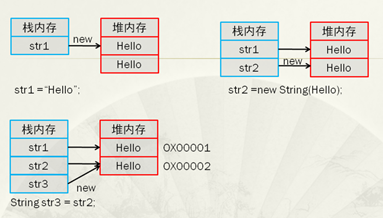
现在使用了“==”的确是完成了相等的判断,但是最终判断的是两个对象(现在的对象是字符串)判断是否相等,属于数值判断------判断的是两个对象的内存地址数值,并没有判断内容,而想要完成字符串内容的判断,则就必须使用到String类的操作方法:public Boolean equals(String str)(将方法暂时变了) 。
public class StringText{ public static void main(String args[]){ String str1 = "Hello"; String str2 = new String("Hello"); String str3 = str2; //引用传递 System.out.print(str1.equals(str2)); //ture System.out.print(str2.equals(str3)); //ture System.out.print(str2.equals(str3)); //ture } }
。
如果在程序之中定义了字符串(使用“””),那么这个就表示一个String对象,因为在各个语言之中没有关于字符串数据类型的定义,而Java将其简单的处理了,所以感觉上存在了字符串数据类型.
**范例:**验证字符串是对象的概念 。
public class NiMing{ public static void main(String args[]){ String str = "Hello"; System.out.print("Hello".equals(str)); //通过字符串调用方法 } }
匿名对象可以调用类之中的方法与属性,以上的字符串可以调用了equals()方法,那么它一定是一个对象.
**小技巧:**关于字符串与字符串常量的判断 。
例如:在实际工作之中会有这样一种操作,要求用户输入一个内容,之后判断此内容是否与指定内容相同.
public class NiMing{ public static void main(String args[]){ String str = "Hello"; if(str.equals("Hello")){ System.out.print("条件满足"); } } }
但,既然数据是用户自己输入,那么就有可能没有输入内容.
public class TestDemo1{ public static void main(String args[]){ String str = null; if(str.equals("Hello")){ System.out.print("条件满足"); } } }//报错 Exception in thread "main" java.lang.NullPointerException at NiMing.main(TestDemo1.java:4)//现在将代码反过来操作: public class TestDemo1{ public static void main(String args[]){ String str = null; if("Hello".equals(str)){ System.out.print("条件满足"); } } }
因为字符串常量是匿名对象,匿名对象不可能为null.
。
。
String str = "Hello"; //定义字符串
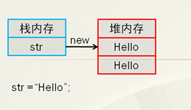
发现现在只开辟额一块堆内存空间和一块栈内存空间.
。
String str = new String("Hello");
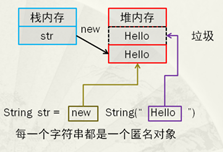
使用构造方法赋值的方式开辟的字符串对象,实际上会开辟两块空间,其中有一块空间就爱那个成为垃圾.
public class TestDemo2{public static void main(String args[]){ String str1 = new String("Hello"); String str2 = "Hello"; //入池 String str3 = "Hello"; //使用池中对象 System.out.print(str1==str2); //false System.out.print(str2==str3); // ture System.out.print(str1==str3); // false } }
通过上面的程序可以发现,使用构造方法实例化String对象,不会入池,只能自己使用。可是在String类之中为了方便操作提供了一种称为手工入池的方法:public String intern().
public class TestDemo2{public static void main(String args[]){ String str1 = new String("Hello").intern(); //手工入池 String str2 = "Hello"; //入池 String str3 = "Hello"; //使用池中对象 System.out.print(str1==str2); //ture System.out.print(str2==str3); //ture System.out.print(str1==str3); //ture } }
。
字符串类的操作特点决定:字符串不可能去修改里面的内容.
public class TestDemo3{ public static void main(String args[]){ String str = "Hello"; str += "World"; str += "!!!"; System.out.print(str); }}
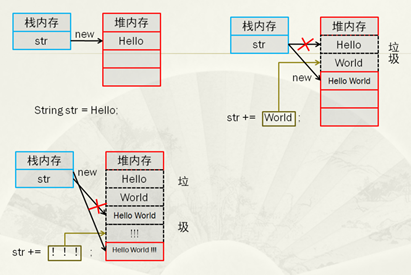
通过以上的代码可以发现,字符串内容的更改,实际上改变的是字符串对象的引用过程,那么一下的代码应该尽量避免:
public class TestDemo3{ public static void main(String args[]){ String str = "Hello"; for(int x=0;x<1000;x++){ str += x; } System.out.print(str); } }
。
任何一个类的文档由如下几个部分组成 。
。
字符串就是一个字符数组,所有在String类中有字符串转变为字符数组,字符数组转换为字符串的方法.
| 方法名称 | 类型 | 描述 |
|---|---|---|
| public String(char[] value) | 构造 | 将字符数组中的所有内容变为字符串 |
| public String(char[] value, int offset, int count) | 构造 | 将字符数组中的所有内容变为字符串 offset-开始 count-个数 |
| public char charAt(int index) | 普通 | 返回char指定字符的索引值 |
| public char[] toCharArray() | 普通 | 将字符串转化为字符数组 |
。
public class TestDemo4{ public static void main(String args[]){ String str = "Hello"; System.out.println(str.charAt(0)); //如果现在超过了字符串的长度,则会产生异常StringIndexOutOfBoundsException System.out.println(str.charAt(10)); }}
字符串和字符数组的转化是重点 。
//字符串转化为字符数组public class TestDemo4{ public static void main(String args[]){ String str = "helloworld"; char data [] = str.toCharArray(); for(int i = 0; i < data.length; i++){ data[i] -= 32; //转大写字母简化模式更简单 System.out.print(data[i] + "、"); } }}
//字符数组转化为字符串public class TestDemo4{ public static void main(String args[]){ String str = "helloworld"; char data [] = str.toCharArray(); for(int i = 0; i < data.length; i++){ data[i] -= 32; //转大写字母简化模式更简单 System.out.print(data[i] + "、"); } System.out.println(); System.out.println(new String(data));//字符串数组全部转化为字符数组 System.out.println(new String(data,1,4));//字符串数组部分转化为字符数组 }}
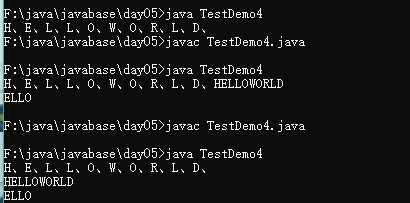
判断字符串是否由数字组成 。
public class TestDemo5{ public static void main(String args[]){ String str1 = "helloworld"; String str = "1234567890"; Judgenum(str); Judgenum(str1); } public static void Judgenum(String str){ char data [] = str.toCharArray(); boolean judge = true; for(int i = 0; i < data.length; i++){ if(data[i]>= "0" && data[i]<= "9"){ judge = false; } } if(judge){ System.out.println(str+"是由字母组成"); }else System.out.println(str+"是由数字组成"); }}

。
| 方法名称 | 类型 | 描述 |
|---|---|---|
| public String(byte[] bytes) | 构造 | 将部分字节数组变为字符串 |
| public String(byte[] bytes, int offset,int length) | 构造 | 将部分字节数组变为字符串 bytes――要解码为字符的字节 offset――要解码的第一个字节的索引 length――要解码的字节数 |
| public byte[] getBytes() | 普通 | 将字符串变为字节数组 |
| public byte[] getBytes(String charsetName) throws UnsupportedEncodingException | 普通 | 编码转换编码 |
//将字符串通过字节流转化为大写public class TestDemo6{ public static void main(String args[]){ String str = "helloworld"; byte data [] = str.getBytes();//字符串转换为字节数组 for(int i = 0; i < data.length ; i++){ System.out.print(data[i]+"、"); data[i] -= 32; } System.out.println(new String(data));//字节数组转化为字符串 }}

一般情况下,在程序之中如果想要操作字节数组只有两种情况:
**1、**需要进行编码的转化; 。
2、 数据要进行传输的时候.
**3、**二进制文件适合字节处理 。
。
| 方法名称 | 类型 | 描述 |
|---|---|---|
| public boolean equals(String anObject) | 普通 | 区分大小写比较 |
| public boolean equalsIgnoreCase(String anotherString) | 普通 | 不区分大小写比较 |
| public int compareTo(String anotherString) | 普通 | 比较两个字符串的大小关系 |
如果现在要比较两个字符串的大小关系,那么就必须使用comepareTo()方法完成,而这个方法返回int型数据,而这个int型数据有三种结果:大于(返回结果大于0)、小于(返回结果小于0)、等于(返回结果为0). 。
public class CompareTo{ public static void main(String args[]){ String str1 = "HELLO"; String str2= "hello"; System.out.println(str1.compareTo(str2)); }}
。
| 方法名称 | 类型 | 描述 |
|---|---|---|
| public boolean contains(String s) | 普通 | 判断一个子字符串是否村存在 |
| public int indexOf(String str) | 普通 | 返回字符串中第一次出现字符串的索引 |
| public int indexOf(String str, int fromIndex) | 普通 | 从指定地方开始查找子字符串的位置 |
| public int lastIndexOf(String str) | 普通 | 从后向前查找子字符串的位置 |
| public int lastIndexOf(String str, int fromIndex) | 普通 | 从指定位置由后向前查找 |
| public boolean startsWith(String prefix) | 普通 | 从头判断是否以某字符串开头 |
| public boolean startsWith(String prefix,int toffset) | 普通 | 从指定位置判断是否以字符串开头 |
| public boolean endsWith(String suffix) | 普通 | 判断以某字符串结尾 |
public class TestDemo7{ public static void main(String args[]){ String str = "helloworld"; System.out.println(str.contains("world")); //true //使用indexOf()进行查找 System.out.println(str.indexOf("world")); System.out.println(str.indexOf("java")); //JDK1,5之前这样使用 if(str.indexOf() != -1){ System.out.println("可以查找到指定的内容"); } }}
public class TestDemo7{ public static void main(String args[]){ String str = "**@@helloworld##"; System.out.println(str.startsWith("**")); //true System.out.println(str.startsWith("@@",2)); //true System.out.println(str.endsWith("##")); //true }}
。
| 方法名称 | 类型 | 描述 |
|---|---|---|
| public String replaceAll(String regex,String replacement) | 普通 | 替换所有的内容 |
| public String replaceFirst(String regex,String replacement) | 普通 | 替换首内容 |
public class TestDemo7{ public static void main(String args[]){ String str = "**@@helloworld##"; System.out.println(str.replaceAll("l","_")); //**@@he__owor_d## }}
。
| 方法名称 | 类型 | 描述 |
|---|---|---|
| public String[] split(String regex) | 普通 | 将字符串全部拆分 |
| public String[] split(String regex,int limit) | 普通 | 将字符串部分拆分 |
public class TestDemo8{ public static void main(String args[]){ String str = "hello world hello zsr hello csdn"; String result [] = str.split(" "); //按照空格进行拆分 //hello、world、hello、zsr、hello、csdn、 for(int i = 0; i < result.length ; i++){ System.out.print(result[i]+"、"); } System.out.println(); //部分拆分 String result1 [] = str.split(" ",3); //按照空格进行拆分 //第二个参数 从第几个位置开始不进行拆分操作 //hello、world、hello zsr hello csdn、 for(int i = 0; i < result1.length ; i++){ System.out.print(result1[i]+"、"); } }}
//拆分ip地址public class TestDemo9{//吴国发现内容无法拆分,就需要用到“”进行转义 public static void main(String args[]){ //120 //11 //219 //223:57114 String str = "120.11.219.223:57114"; String result [] = str.split("."); for(int i = 0 ; i < result.length ; i++){ System.out.println(result[i]); } }}
。
| 方法名称 | 类型 | 描述 |
|---|---|---|
| public String substring(int beginIndex) | 普通 | 从指定位置截取到结尾 |
| public String substring(int beginIndex,int endIndex) | 普通 | 截取部分内容 |
public class TestDemo10{ public static void main(String args[]){ String str = "helloworld"; //world System.out.println(str.substring(5)); //hello System.out.println(str.substring(0,5)); }}
。
| 方法名称 | 类型 | 描述 |
|---|---|---|
| Public String trim() | 普通 | 去掉左右空格,保留中间空格 |
| public String toUpperCase() | 普通 | 将全部字符串转大写 |
| public String toLowerCase() | 普通 | 将全部字符串转小写 |
| public String intern() | 普通 | 字符串入对象池 |
| public String concat() | 普通 | 字符串连接 |
。
1.现在给出了如下一个字符串格式:“姓名:成绩|姓名:成绩|姓名:成绩”,例如:给定的字符串是:“Tom:90|Jerry:80|tony:89”,要求可以对以上数据进行处理,将数据按照如下的形式显示:姓名:Tom,成绩:90; 。
public class Exam1{ public static void main(String args[]){ String str = "Tom:90|Jerry:80|tony:89"; String data [] = str.split("|"); for(int i = 0 ; i < data.length ; i++){ String result [] = data[i].split(":"); System.out.print("姓名 = " + result[0] + ","); System.out.println("年龄 = " + result[1]); } /*姓名 = Tom,年龄 = 90 姓名 = Jerry,年龄 = 80 姓名 = tony,年龄 = 89*/ }}
2.给定一个email地址,要求验证其是否正确,提示:可以简单的验证一下,重点验证“@”和“.”。标准如下:
1.email长度不短于5 。
2.@和.不能做开头或结尾 。
3.@和.顺序要有定义 。
public class Exam2{ public static void main(String args[]){ String email = "1016942589.@qqcom"; char date[] = email.toCharArray(); if (date.length>5&&email.startsWith("@")==false && email.startsWith(".")==false && email.endsWith("@")==false &&email.endsWith(".")==false && email.indexOf(".") >email.indexOf("@")) {System.out.println("正确"); }else{System.out.println("错误");} }}
。
本篇文章就到这里了,希望能给你带来帮助,也希望您能够多多关注我的更多内容! 。
原文链接:https://blog.csdn.net/zsr6135/article/details/119272690 。
最后此篇关于java基础的详细了解第五天的文章就讲到这里了,如果你想了解更多关于java基础的详细了解第五天的内容请搜索CFSDN的文章或继续浏览相关文章,希望大家以后支持我的博客! 。
vue3 快速入门系列 - 基础 前面我们已经用 vue2 和 react 做过开发了。 从 vue2 升级到 vue3 成本较大,特别是较大的项目。所以许多公司对旧项目继续使用vue2,新项目则
C# 基础 C#项目创建 这里注意win10虚拟机需要更新下补丁,不然直接下载visual studio 2022会显示版本不支持 HelloWorld C#的类文件都是以.cs结尾,入口方法为sta
关于 iPhone 内存管理的非常基本的问题: 假设我有一个 viewController,其中有几个 subview 也由 viewController 控制。当我删除顶部 viewControll
我仍在努力适应指针。不是概念——我理解内存位置、匹配可变长度的指针增量等——这是语法。这是一个我认为是我感到困惑/无法直观把握的原因之一: int a = 42; 在一个int大小的内存空间中分配并放
1. 简介 Kafka(Apache Kafka) 是一种分布式流数据平台,最初由LinkedIn开发,并于后来捐赠给Apache软件基金会,成为了一个Apache顶级项目。它被设计用于处理大规
1.想要在命令提示符下操作mysql服务器,添加系统变量。(计算机-系统属性——环境变量——path) 2.查询数据表中的数据; select selection_lis
MySQL表的增删改查(基础) 1. CRUD 注释:在SQL中可以使用“–空格+描述”来表示注释说明 CRUD 即增加(Create)、查询(Retrieve)、更新(Update)、删除(Dele
我有一个网页,可以在加载时打开显示模式,在这个模式中,我有一个可以打开第二个模式的链接。当第二个模式关闭时(通过单击关闭按钮或单击模式外部),我想重新打开第一个模式。 对于关闭按钮,我可以通过向具有
使用 Core Data Fetched Properties,我如何执行这个简单的请求: 我希望获取的属性 ( myFetchProp ) 存储 StoreA ,它应该这样做: [myFetchPr
关闭。这个问题是opinion-based .它目前不接受答案。 想改进这个问题?更新问题,以便 editing this post 可以用事实和引用来回答它. 8年前关闭。 Improve this
最近,我得到了一个现有的Drupal项目,并被要求改进前端(HTML,JavaScript,CSS)。我在Django,PHP,Ruby等方面具有大量的前端和后端开发经验,但是我没有任何Drupal经
我试图让我的用户通过使用扫描仪类来决定要做什么,但我有一个问题,代码一旦运行就不会激活,并且它不会让我跳过任何行。我的代码如下所示: Scanner input = new Scanner(S
对模糊的标题表示歉意,因为我想不出这个名字是什么。 基本上创建一个计算学生财务付款的小程序。当我运行它时,它计算对象限额没有问题。然而,无论我尝试什么,对象“助学金”似乎除了 0 之外什么也没有提出。
这是我的代码 - main() { double x; double y = pow(((1/3 + sin(x/2))(pow(x, 3) + 3)), 1/3); prin
如果我的术语在这个问题上有误,我们深表歉意。 采取以下功能: i = 1; v = i * 2; for (j = 0; j < 4; j++ ) { console.log(v);
我的应用程序中有不同的类文件。我有 5 个类,其中 2 个是 Activity ,1 个是运行的服务。其他 2 个只是类。这两个类中变量的生命周期是多少。我知道一个 Activity 可以被操作系统杀
例如,一个方法返回一个 List 类型的对象。 public List bojangles () ... 一些代码调用方法FooBar.bojangles.iterator(); 我是 Java 的新
我遇到了一个奇怪的问题,网格的大小不适合我的屏幕。当我使用 12 列大时,它只占据屏幕的 1/3 的中间,请参见图像。我不确定是什么导致了这个问题。我没有任何会导致这种情况发生的奇怪 CSS。我不会在
我尝试使用头文件和源文件,但遇到了问题。因此,我对我正在尝试做的事情做了一个简化版本,我在 CodeBlocks 中遇到了同样的错误(undefined reference to add(double
我正在为我的网格系统使用基础,但这在任何网格系统中都可能是一个问题。我基本上用一个容器包裹了 3 个单元格,但其中一个单元格应该长到页面边框(留在我的 Sampe-Image 中)但这也可能在右侧)。

我是一名优秀的程序员,十分优秀!